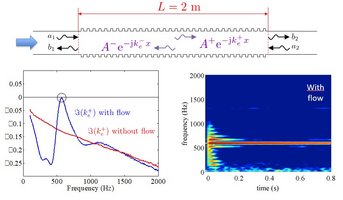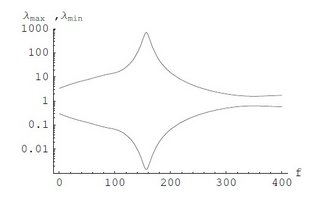Self-excited Instabilities in Aero- and Thermoacoustics (SelfiXs)
International Collaborative Research Project - ANR-DFG NLE 2018
by Kah Joon Yong and Wolfgang Polifke
Motivation
Self-excited oscillations are the result of flow-acoustic or flow-flame-acoustic feedback mechanism in fluidmechanical systems. Thermoacoustics describes a process involving exchange in perturbation energy between heat and acoustics, whereas aeroacoustics describes the interaction between flow and acoustics. In systems involving energy conversion and distribution such as gas turbine engines and power plants, these self-excited oscillations are undesirable as they can generate high levels of pulsations, which lead to environmental, reliability and safety problems. For instance, combustion instabilities caused by the flow-flame-acoustic feedback in a combustion chamber perturbs the heat release rate which contributes to reduced performance and elevated emissions of noise and pollutants. Acoustic perturbations also induce vibrations in the mechanical structures and consequently accelerates material fatigue. Evidently, the main focus in the field of aero- and thermoacoustics revolves around the methods in identifying, analysing, quantifying, modeling and most importantly reducing such thermoacoustic instabilities.
However, there is a different branch in thermoacoustics, where the thermoacoustic perturbation is actively encouraged, namely in a thermoacoustic device. The work of Backhaus et al [1] has shown the potential of a Stirling heat engine in utilizing acoustic resonance to transport and convert heat energy to usable work. Lawn and Penelet have subsequently detailed the common functionality of thermoacoustic devices in their work [2]. A thermoacoustic refrigerator takes an acoustic input to concentrate and remove the heat energy from its heat source, i.e. a refrigeration. On the other hand, a themoacoustic prime mover uses a heat input to generate acoustic waves, which can later be used to produce mechanical work. In both systems, the amplification of acoustic energy is desired as it defines the primary functionality of the devices.
Processes with Self-excited oscillations: In combustion systems, combustion instabilities arises from the unsteady flames interacting with the flow parameters. Recently, the Intrinsic Thermoacoustic Modes, which are attributed to the flame-intrinsic-feedback loop [3], has been observed. Aeroacoustic instabilities have been observed in corrugated ducts, where periodic stack of orifices is able to ‘whistle’ at certain frequency. The instability potentiality of the corrugated ducts is investigated in terms of its PT-symmetricity by Achilleos et al [4]. Beside that, thermoacoustic oscillation is utilized the aforementioned thermoacoustic engine, where heat energy is converted to mechanical energy, or simply concentrated and transported with resonating acoustic waves.
Gain and loss of perturbation energy: Analysis of aero- and thermoacoustic phenomena in relation to self-excited instabilities is usually formulated in terms of equations for the amplitudes or fluctuations of flow variables (p, u, q), e.g. eigenvalue analysis. Alternative methods of analysis focusing on a balance of perturbation energy can provide insights to the physical mechanisms invloved. This methodology can be applied to several thermoacoustic phenomena, which have previously been investigated either experimentally [4-6] or numerically [3,7-8]. These works have already generated unique insights in aero- and thermoacoustic processes such as the whistling potentiality of multi-port systems, instability potentiality and intrinsic thermoacoustic feedback in combustion systems, and CPA-Laser properties in a PT-symmetric acoustic system. They will be also the subject of ongoing investigations.
Objectives and Strategy
In the framework of the SelfiXs (Self-excited Instabilities in Aero- and ThermoacoustiXs), the generation and annihiliation of perturbation energy in aero- and thermoacoustic systems will be the focus of investigations. The project will study flow-(flame-) acoustic coupling in general and strive to derive the underlying physical mechanisms involved in the different thermoacoustic processes.
One major aspect of SelfiX is exploiting the results obtained in non-Hermitian physics [4,5,9] to increase our fundamental understanding of the flow-flame-acoustic mechanisms. Based on this understanding, analytical models, simulation tools, optimization criteria and design principles for secure and reliable thermoacoustic systems will be developed. Furthermore, the results will be extended to thermoacoustic engine with the aim to increase its performance and efficiency.
The project will investigate, by means of experiment, analysis and simulation, three configurations that can develop self-excited instabilies due to flow-heat-acoustic interactions, 1) corrugated ducts, 2) thermoacoustic engines, 3) premix combustion systems. These three configurations are exemplary for aero-acoustics, thermoacoustics and combustion dynamics research communities, respectively. As such, SelfiXs aimed to connect these communities by bringing together researchers from these three fields.
Several concrete challenges and therefore tasks have been identified for this project. The first one is to compute the aero-acoustic characteristics of corrugated pipes by wall resolved Large Eddy Simulation (LES) of compressible flow in a system with periodic orifices. This has been attempted in the case of acoustic liners for aircraft engines with large number of small holes [10,11] and has been proven to be a challenging task due to the interaction between acoustic propagative, acoustic evanescent and hydrodynamic modes. These different types of modes have wavelengths of different order, thus it is important to take into account very small details of the geometry and the fluid in the small scale turbulent simulation. The computations in SelfiXs are primarily planned for larger geometries with reduced-order model and scale separation. A less accurate method, such as the RANS k-ε model, is planned as a fallback method.
The second challenge is the experimental investigation of systems with high gain while remaining in linear regime for a thermoacoustic engine. At high gain, the splitting of very small incoming wave and very large outgoing waves demands very accurate detection methods. On top of that, a very high gain system is susceptible to small imperfections, as the system usually prones to whistle. A fallback solution is to decrease the gain to obtain less spectacular, but more stable systems.
The final challenge is to define general criteria that govern the design of intrinsically stable burners. In case of difficulty to find general rules, the study will concentrate on small number of particular designs. In a similar way the results should allow a definition of general rules in design optimization of thermoacoustic systems devoted to waste heat recovery at low temperatures.
References
[1] S. Backhaus and G. W. Swift, “A thermoacoustic-Stirling heat engine: Detailed study,” The Journal of the Acoustical Society of America, vol. 107, no. 6, pp. 3148–3166, 2000, doi: 10.1121/1.429343.
[2] C. J. Lawn and G. Penelet, “Common features in the thermoacoustics of flames and engines,” International Journal of Spray and Combustion Dynamics, p. 1756827717743911, Dec. 2017, doi: 10.1177/1756827717743911.
[3] T. Emmert, S. Bomberg, and W. Polifke, “Intrinsic Thermoacoustic Instability of Premixed Flames,” Combustion and Flame, vol. 162, no. 1, pp. 75–85, 2015, doi: 10.1016/j.combustflame.2014.06.008.
[4] V. Achilleos, Y. Aurégan, and V. Pagneux, “Scattering by finite periodic PT-symmetric structures,” arXiv preprint arXiv:1703.07428, 2017, Accessed: May 18, 2017. [Online]. Available: https://arxiv.org/abs/1703.07428.
[5] Y. Aurégan and V. Pagneux, “PT-Symmetric Scattering in Flow Duct Acoustics,” Physical Review Letters, vol. 118, no. 17, p. 174301, 2017.
[6] Y. Aurégan and R. Starobinski, “Determination of Acoustical Energy Dissipation/Production Potentiality from the Acoustical Transfer Functions of a Multiport,” Acta Acustica united with Acustica, vol. 85, no. 6, pp. 788–792, 1999.
[7] W. Polifke, “Thermo-Acoustic Instability Potentiality of a Premix Burner,” in European Combustion Meeting, ECM2011, Cardiff, UK, Jul. 2011.
[8] S. Bomberg, T. Emmert, and W. Polifke, “Thermal Versus Acoustic Response of Velocity Sensitive Premixed Flames,” Proceedings of the Combustion Institute, vol. 35, no. 3, pp. 3185–3192, 2015, doi: 10.1016/j.proci.2014.07.032.
[9] CM. Bender and S. Boettcher. “Real spectra in non-hermitian hamiltonians having PT symmetry”. Phys. Rev. Lett., 80:5243-5246, Jun 1998.
[10] X. Dai, and Y. Aurégan, “Acoustic of a perforated liner with grazing flow: Floquet-Bloch periodical approach versus impedance continuous approach.” The Journal of the Acoustical Society of America. 140. 2047-2055, 2016. doi: 10.1121/1.4962490.
[11] P. Testud, Y. Aurégan, P. Moussou, and A. Hirschberg, “The whistling potentiality of an orifice in a confined flow using an energetic criterion,” Journal of Sound and Vibration, vol. 325, no. 4–5, pp. 769–780, Sep. 2009, doi: 10.1016/j.jsv.2009.03.046.
Acknowledgement
Financial support has been provided by the German Research Foundation (DFG) in the framework of the International Collaborative Research Project Initiative ANR-DFG NLE 2018, whose support is gratefully acknowledged. This project is carried out in collaboration with LAUM, France, whose coorporation is highly appreciated.



